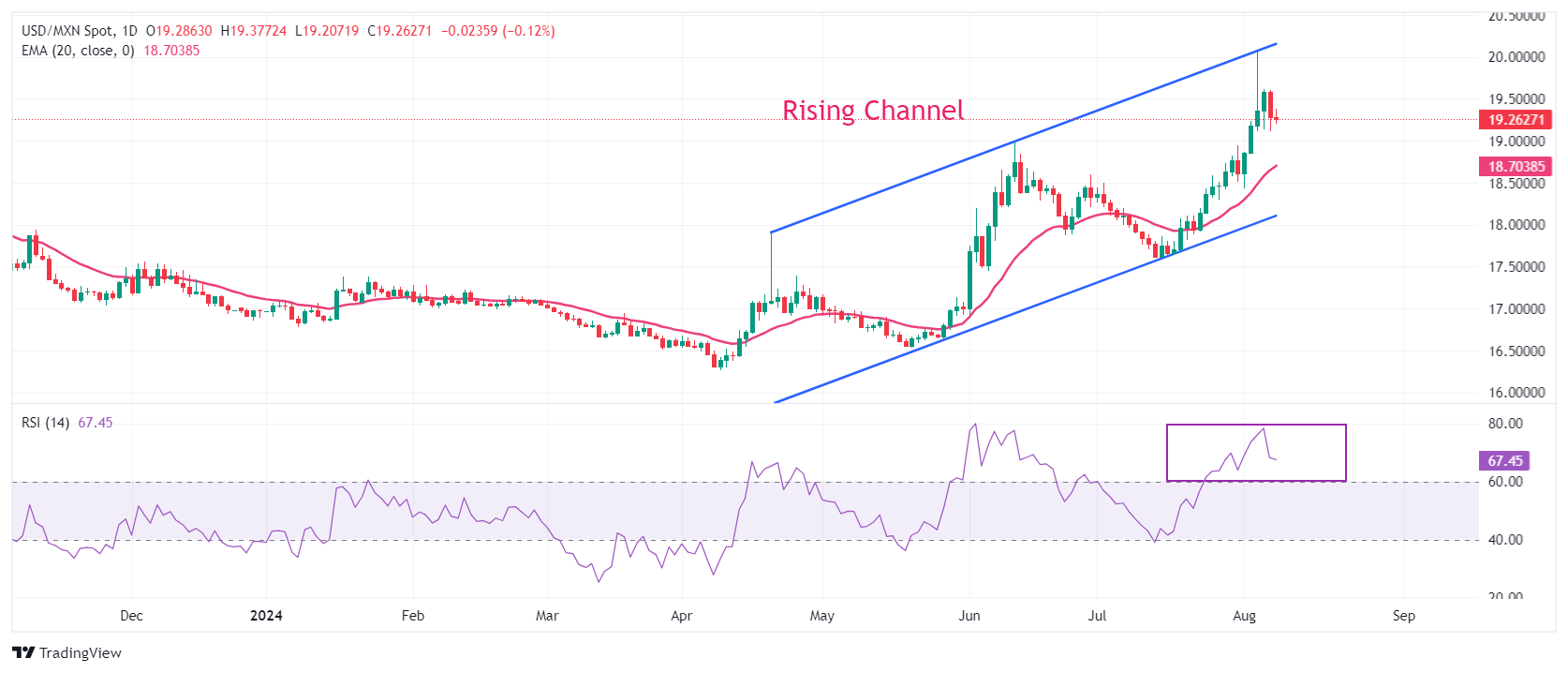- Analytics
- News and Tools
- Market News
- USD/MXN Price Forecast: Stays in tight range above 19.00
USD/MXN Price Forecast: Stays in tight range above 19.00
- USD/MXN trades back and forth above $19.00 despite the volatile US Dollar.
- The Fed is expected to bring down interest rates aggressively.
- USD/MXN trades inside the Rising Channel chart pattern.
The USD/MXN pair trades in a limited range above the crucial support of 19.00 in Thursday’s European session. The asset consolidates from the last three trading sessions despite the US Dollar (USD) exhibiting sheer volatility.
The US Dollar Index (DXY), which tracks the Greenback’s value against six major currencies, corrects to near 103.00 on firm speculation that the Federal Reserve (Fed) will pivot to policy-normalization aggressively. 10-year US Treasury yields tumble to near 3.90%.
Meanwhile, investors await the United States (US) Initial Jobless Claims data for the week ending August 2, which will be published at 12:30 GMT. Investors will keenly focus on the weekly jobless claims as it is the only data available that will provide some cues about the current status of the labor market.
On the Mexican Peso front, the Mexican currency will be influenced by the spectre of controversial reforms to Mexico's constitution set for votes next month, including a potential judicial overhaul that would subject judges to popular vote, Reuters reported.
USD/MXN trades in a Rising Channel formation on a daily timeframe in which each pullback is considered as buying opportunity by market participants. The asset appears to be in a strong uptrend as the 20-day Exponential Moving Average (EMA) near $28.70 slopes higher.
The 14-day Relative Strength Index (RSI) oscillates in the 60.00-80.00 range, suggesting a strong upside momentum.
Fresh upside would appear if the asset breaks above August 6 high of 19.61, which will drive the asset towards fresh annual high near $20, followed by almost two-year high of 20.50.
USD/MXN daily chart
Mexican Peso FAQs
The Mexican Peso (MXN) is the most traded currency among its Latin American peers. Its value is broadly determined by the performance of the Mexican economy, the country’s central bank’s policy, the amount of foreign investment in the country and even the levels of remittances sent by Mexicans who live abroad, particularly in the United States. Geopolitical trends can also move MXN: for example, the process of nearshoring – or the decision by some firms to relocate manufacturing capacity and supply chains closer to their home countries – is also seen as a catalyst for the Mexican currency as the country is considered a key manufacturing hub in the American continent. Another catalyst for MXN is Oil prices as Mexico is a key exporter of the commodity.
The main objective of Mexico’s central bank, also known as Banxico, is to maintain inflation at low and stable levels (at or close to its target of 3%, the midpoint in a tolerance band of between 2% and 4%). To this end, the bank sets an appropriate level of interest rates. When inflation is too high, Banxico will attempt to tame it by raising interest rates, making it more expensive for households and businesses to borrow money, thus cooling demand and the overall economy. Higher interest rates are generally positive for the Mexican Peso (MXN) as they lead to higher yields, making the country a more attractive place for investors. On the contrary, lower interest rates tend to weaken MXN.
Macroeconomic data releases are key to assess the state of the economy and can have an impact on the Mexican Peso (MXN) valuation. A strong Mexican economy, based on high economic growth, low unemployment and high confidence is good for MXN. Not only does it attract more foreign investment but it may encourage the Bank of Mexico (Banxico) to increase interest rates, particularly if this strength comes together with elevated inflation. However, if economic data is weak, MXN is likely to depreciate.
As an emerging-market currency, the Mexican Peso (MXN) tends to strive during risk-on periods, or when investors perceive that broader market risks are low and thus are eager to engage with investments that carry a higher risk. Conversely, MXN tends to weaken at times of market turbulence or economic uncertainty as investors tend to sell higher-risk assets and flee to the more-stable safe havens.
© 2000-2025. All rights reserved.
This site is managed by Teletrade D.J. LLC 2351 LLC 2022 (Euro House, Richmond Hill Road, Kingstown, VC0100, St. Vincent and the Grenadines).
The information on this website is for informational purposes only and does not constitute any investment advice.
The company does not serve or provide services to customers who are residents of the US, Canada, Iran, The Democratic People's Republic of Korea, Yemen and FATF blacklisted countries.
Making transactions on financial markets with marginal financial instruments opens up wide possibilities and allows investors who are willing to take risks to earn high profits, carrying a potentially high risk of losses at the same time. Therefore you should responsibly approach the issue of choosing the appropriate investment strategy, taking the available resources into account, before starting trading.
Use of the information: full or partial use of materials from this website must always be referenced to TeleTrade as the source of information. Use of the materials on the Internet must be accompanied by a hyperlink to teletrade.org. Automatic import of materials and information from this website is prohibited.
Please contact our PR department if you have any questions or need assistance at pr@teletrade.global.
















